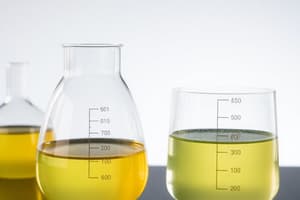Podcast
Questions and Answers
What happens to a buffer solution when a strong base is added?
What happens to a buffer solution when a strong base is added?
- The solution becomes more acidic
- The solution becomes more basic
- The solution is protected by the acid CH3COOH (correct)
- The pH of the solution remains unchanged
What happens to a buffer solution when a strong acid is added?
What happens to a buffer solution when a strong acid is added?
- The solution becomes more acidic
- The solution is protected by acetate (CH3COO-) (correct)
- The pH of the solution remains unchanged
- The solution becomes more basic
What does acetate (CH3COO-) do when strong base (OH-) is added to a buffer solution?
What does acetate (CH3COO-) do when strong base (OH-) is added to a buffer solution?
- Reacts with OH- to form a stronger base
- Converts excess protons and uses them to manufacture more weak acid, preventing large increase in pH (correct)
- Remains unchanged in the solution
- Breaks down into its constituent ions
What is the molar ratio, [Salt]/[Acid], required to prepare an acetate buffer of pH 5.0?
What is the molar ratio, [Salt]/[Acid], required to prepare an acetate buffer of pH 5.0?
What is the pH of a solution containing 0.10 mole of ephedrine and 0.01 mole of ephedrine hydrochloride per liter of solution?
What is the pH of a solution containing 0.10 mole of ephedrine and 0.01 mole of ephedrine hydrochloride per liter of solution?
Flashcards are hidden until you start studying
Study Notes
Buffers
- A buffer is a compound or mixture of compounds that resists changes in pH when small amounts of strong acid or base are added to a solution.
- Buffers can be a combination of a weak acid and its conjugate base (e.g., HAc and NaAc) or a weak base and its conjugate acid (e.g., Ephedrine and Ephedrine HCl or NH3 and NH4Cl).
Buffer Action
- Buffer action is the resistance of a buffer to changes in pH.
- When a small amount of strong acid or base is added to water or a solution of sodium chloride, the pH changes significantly, demonstrating a lack of buffer action.
Buffer Capacity (β)
- Buffer capacity (β) measures the magnitude of a buffer's resistance to pH changes.
- High buffer capacity is necessary to maintain a constant pH, such as in blood, which is maintained at pH 7.4.
Importance of Buffers
- Buffers are frequently used in pharmaceutical practice to hold the pH constant, particularly in ophthalmic and I.V. injections.
- The ability of a buffer to resist changes in pH is crucial in these applications.
Studying That Suits You
Use AI to generate personalized quizzes and flashcards to suit your learning preferences.




